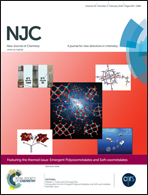In silico studies with substituted adenines to achieve a remarkable stability of mispairs with thymine nucleobase†
Abstract
DNA nucleobases are prone to undergo modification by deamination, oxidation, alkylation or hydrolysis processes because of their reactive nature. Many of these damaged DNA nucleobases are highly susceptible to mutagenesis when formed in cellular DNA, and such modified nucleobases can be mispaired by a DNA polymerase during replication. Mispair formation has largely been carried out with modified uracil and guanine nucleobases, while the reports on mispair formation with modified adenines are scarce in the literature. Research into adenine mispairs is limited due to the lower number of hydrogen bonding sites and orientations of hydrogen bonding donor and acceptor in such mispairs. We have explored mispair formation between modified adenine and thymine nucleobases and found that substitutions at the 2-position of adenine with –NH2/–OH groups augmented the stability compared to the typical A–T base pair. Furthermore, substituents at the remote position of adenine nucleobase also enhanced the interaction energies of the mispairs. The nitrogen/oxygen-lithiated adenines showed remarkable stability for mispairs with a thymine base. The di-coordinated N/O-lithiated adenine and thymine mispairs were found to be stable at ∼12.0 kcal mol−1 compared to the A–T base pair. We also studied the mispairing interaction with a tetra-coordinated lithiated adenine and thymine mispair, where lithium was coordinated with two water molecules. The interaction free energy calculated with a M06-2X/6-31+G(d,p) level of theory for such tetra-coordinated lithiated adenine thymine mispairs is ∼−30.0 kcal mol−1. The EDA analysis suggested that the electrostatic interaction energy contributes more to the total interaction energy calculated for such mispairs. The ab initio molecular dynamics (ADMP) simulations showed that the formation of mispairs with modified adenine is stable and the deviations in their geometries are minimal with time. This study reveals that suitable modifications in adenine nucleobase can lead to very stable mispairs with the thymine nucleobase, which are in some cases comparable to G–U mispairs.


 Please wait while we load your content...
Please wait while we load your content...